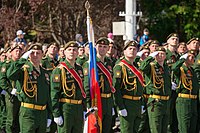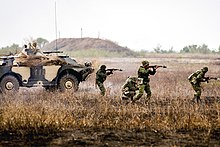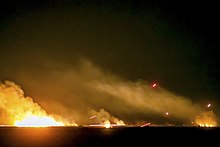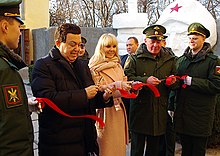Operational Group of Russian Forces
| Operational Group of Russian Forces in Transnistria | |
|---|---|
| Оперативная группа российских войск в Приднестровье | |
 | |
| Active | 1995–present |
| Country | |
| Branch | |
| Type | Task force |
| Role | Peacekeeping (disputed) |
| Size | 1,500 soldiers |
| Part of | Moscow Military District |
| Headquarters | Tiraspol |
The Operational Group of Russian Forces in Transnistria (OGRF; Romanian: Grupul Operativ al Trupelor Ruse din Transnistria, GOTR; Russian: Оперативная группа российских войск в Приднестровье, romanized: Operativnaya grupoa rossiyskikh voysk v Pridnestrovye, ОГРВ) is a sizable overseas military task force of the Russian Armed Forces. It serves as part of the tri-lateral Joint Control Commission (JCC) in the region with around 350 soldiers provided to the JCC.
1,500 soldiers of the military force are based at the former decommissioned Soviet-era ammunition depot at Cobasna, where it guards around 22,000 tons of military equipment and ammunition.[1][2][3][4] The core of the OGRF consists of 70 to 100 Russian officers, with the rest being Transnistrian locals employed as soldiers. Troops of the OGRF are rotated once every six months.[5]
History

14th Army background and Transnistria War
The Soviet Army's 14th Guards Army (Russian: 14-я гвардейская армия) was formed in November 1956 in Chișinău as one of the only formation of the Odessa Military District to be stationed in the Moldovan SSR. The army headquarters was moved to Tiraspol, the capital of Pridnestrovian Moldavian Soviet Socialist Republic in the early 1980s.[6][7][8] At the start of the Transnistrian War, soldiers of the 14th Guards Army who were sympathetic to the PMR cause "defected" with total military structure and commanding system, and remained under Moscow command, and, with some assistance of the Transnistrian Republican Guard, created the strongest local military force, despite the Russian government's official declaration of neutrality.[9] On 23 June 1992, Major General Alexander Lebed of the 14th Guards Army, who had orders to evacuate the local logistics center, began an over two week battle which ended in an artillery strike on 3 July 1992 on a Moldovan unit in a forest near Bender (Tighina). It is generally accepted that this strike led to the strategic victory of the Transnistrian/Russian military and the tactical setbacks of the military of Moldova, creating a Moscow-controlled occupational zone, and a Moldovan government had lost control over a part of Moldova.[10]
OGRF establishment
After the war, the 14th Army was split between the Ukrainian Armed Forces and the Russian Army, with most of the Russian contingent being absorbed into Western Military District. The conclusion of the conflict in a cease-fire resulted in the beginning of trilateral negotiations between the governments and militaries of Russia, Transnistria and Moldova, which eventually led to the discussion of a joint peacekeeping force.[11] In June 1995, the Operational Group of Russian Forces in Transnistria was founded by order of the General Staff of the Russian Armed Forces.[12] In 2005, the force consisted of the 8th Guards Motor Rifle Brigade, the 1162nd Anti-Aircraft Rocket Regiment, 15th Signals Regiment, as well as other support units.[13]
The OGRF today
The OGRF ostensibly remains in Transnistria to guard the ammunition depot at Cobasna.[14] It also provides additional support to the Armed Forces of Transnistria. Today, around 350–400 troops with the operational force report directly to the JCC and can be assigned to it at any given time.[15] The task force provides the largest contingent of soldiers in the region. On 27 June 2016, the Transnistrian government passed new law which penalized any actions or public statements that criticize the OGRF. The punishment for committing this crime is 3–7 years in jail.[16] In recent years, the OGRF has taken part in Victory Day Parades on Suvorov Square, to condemnation from Chisinau.[17]
Calls for withdraw and UN resolution
Since its introduction, the OGRF has been met with criticism from both Moldovan and Western officials and observers, all of whom claim that the Russian military presence is either illegal or unnecessary. In November 2008, the NATO Parliamentary Assembly adopted a resolution, urging Russia to withdraw the force in accordance with its commitments at the 1999 Istanbul summit of the Organization for Security and Co-operation in Europe.[18]
In June 2018, United Nations General Assembly adopted resolution (document A/72/L.58), which essentially called on the Russian Federation to withdraw the OGRF from Moldovan territory immediately. While the Moldovan government led by Pavel Filip supported it, President Igor Dodon condemned the resolution, saying that the Russian presence led to the "creation of conditions for a political process of negotiations".[19][20] Previously, Dodon supported the Moldovan parliament on this issue.[21]
In 2020, Moldovan president-elect Maia Sandu declared that OGRF should withdraw from the breakaway Transnistria, saying to the RBK that although they guard ammunition depots, "there are no bilateral agreements on the OGRF and on the weapons depots.” She also stated that its her position that the "mission should be transformed into an OSCE civilian observer mission.”[22]
In 2022, as the Russian invasion of Ukraine was taking place, the Chief Directorate of Intelligence of the Ministry of Defence of Ukraine reported that residents in Transnistria were refusing to sign contracts with the Operational Group of Russian Forces despite being promised "high cash payments, social packages, and likely housing". The report also said that there were being several cases of desertion in the military unit and that there were not enough necessary resources to search for and recover soldiers.[23] In 2022, Moldova continued blocking the rotation of soldiers with Russia and stopping new weapons being brought in, saying the soldiers are there illegally. Previously Russians had entered Transnistria via Ukraine, this issue affects the 70-100 Russian officers.[5]
Structure (as of 2015)

- Group headquarters
- 82nd Separate Guards Motorized Rifle Battalion
- Battalion HQ
- 4 Motorized Rifle Companies
- Headquarters platoon
- Grenadier Platoon
- Technical Support Platoon
- Material Support Platoon
- Medical Platoon
- 113th Separate Guards Motorized Rifle Battalion
- Battalion HQ
- 4 Motorized Rifle Companies
- Headquarters platoon
- Grenadier Platoon
- Technical Support Platoon
- Material Support Platoon
- Medical Platoon
- 540th Separate Command Battalion
- Battalion HQ
- Guard Company
- Company headquarters
- 4 guard platoons
- Counterintelligence Department of the FSB
- Communication Center
- Field Mail Station
- Engineering Platoon
- Storage Department
- Maintenance Company (equipped with MTO-AT-M1)[24]
- Material Support Company
- Fuel depot
- Military band
- Firing range
Commanders of the OGRF

The following generals commanded the unit:
- Lieutenant General Valery Yevnevich (November 1995–16 January 2002)
- Major General Boris Sergeev (16 January 2002 – 11 September 2009)
- Colonel Vyacheslav Sitchikhin (11 September 2009 – 2010)
- Colonel Sergey Nyrkov (2010–2011)
- Colonel Valery Plohotnyuk (1 December 2011 – 15 March 2013)
- Colonel Sergey Goryachev (15 March 2013 – 25 December 2014)
- Colonel Dmitry Zelenkov (25 December 2014–present)
See also
- List of Russian military bases abroad
- Russian military presence in Transnistria
- 59th Guards Motor Rifle Division
References
- ^ "Russian Military Games on Dniester Anger Moldova". 15 August 2018.
- ^ "Agonia limbii române în Transnistria", Adevărul, 3 December 2012
- ^ "Prime Minister of Moldova calls for withdrawal of Russian troops from Transnistria".
- ^ Ian Johnstone (ed), Annual Review of Global Peace Operations 2007, Lynne Rienner Publishers, Boulder/London, p.131
- ^ a b Necșuțu, Mădălin (22 July 2022). "Moldova Defends Action, Blocking Russian Troop Rotation in Transnistria". Balkan Insight.
- ^ Holm, "14th Guards Red Banner Combined Arms Army"
- ^ ""Russian troops in Transnistria – a threat to the security of the Republic of Moldova"". Archived from the original on 2007-10-15. Retrieved 2019-06-07.
- ^ "Командующий 14-Й Российской Армией В Приднестровье Александр Лебедь: "Под Моими Воротами Можно Визжать Сколько Годно. Это Ничего Не Изменит..."".
- ^ Transnistria: relic of a bygone era
- ^ "Operational Group of Russian Forces in Moldova".
- ^ "U.S. and Russian Policymaking With Respect to the Use of Force", chapter 4, Trans-Dniestria
- ^ Michael Holm. "14th Guards Combined Arms Army". www.ww2.dk. Retrieved 2019-06-07.
- ^ "Что такое современная армия России"
- ^ "Prime Minister of Moldova calls for withdrawal of Russian troops from Transnistria".
- ^ "Время Местное – 183". Archived from the original on 2016-03-04. Retrieved 2019-06-07.
- ^ Liubec, Igor (29 June 2016). "La Tiraspol, faci pușcărie, dacă negi "rolul pozitiv" al armatei ruse" [Those who deny the "positive role" of the Russian Army in Tiraspol face prison]. Deschide Știrea (in Romanian). Archived from the original on 2 January 2018. Retrieved 6 June 2019.
- ^ "UAWire – Moldova condemns participation of Russian troops in Victory Day parade in Transnistria".
- ^ "NATO-resolution. 11. b." Archived from the original on 2012-03-20. Retrieved 2008-11-19.
- ^ "UAWire – President of Moldova speaks against withdrawal of Russian troops from Transnistria".
- ^ "Moldovan President condemns calls for withdrawal of Russian peacekeepers from Transnistria".
- ^ "Is it worthy ceding Transnistria to "neutral" Moldova?: EADaily". 5 April 2018. Retrieved 6 June 2019.
- ^ "Pull Russian Troops Out of Moldova, New President Says". The Moscow Times. 2020-11-30. Retrieved 2020-12-04.
- ^ Strozewski, Zoe (8 September 2022). "Russian force sees 'mass desertion' amid Putin's recruitment push: report". Newsweek.
- ^ In the Operational Group of Russian Troops in Pridnestrovie, a lesson was held with specialists from the repair company. Russian MOD
